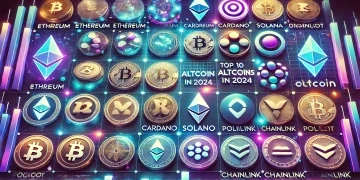Blockchain technology, led by pioneers like Ethereum, has transformed various industries by introducing decentralized applications, smart contracts, and digital assets. However, one of the biggest challenges blockchain networks face today is scalability. As adoption grows, the ability of blockchain platforms to handle more transactions efficiently and at lower costs becomes a critical issue. Ethereum 2.0, a long-anticipated upgrade, is set to address these challenges and revolutionize blockchain scalability in 2024.
This article will explore how Ethereum 2.0 aims to solve the scalability problem, its key technological innovations, and the broader implications for the blockchain ecosystem.
Understanding the Scalability Problem in Ethereum 1.0
Before diving into Ethereum 2.0, it’s important to understand why scalability is such a pressing issue in Ethereum’s current form, often referred to as Ethereum 1.0. Ethereum 1.0 operates on a proof-of-work (PoW) consensus mechanism, similar to Bitcoin, where miners compete to solve complex mathematical problems to validate transactions and secure the network. While PoW provides a high level of security and decentralization, it has significant limitations when it comes to scalability.
The Ethereum network can currently process about 15–30 transactions per second (TPS), which pales in comparison to traditional payment systems like Visa, which can handle thousands of TPS. As more users and decentralized applications (dApps) join the Ethereum network, the demand for block space increases, leading to network congestion and higher gas fees (transaction costs). This was especially evident during the 2021 DeFi (Decentralized Finance) and NFT (Non-Fungible Token) booms, when gas fees skyrocketed, making the network less accessible for smaller users.
Ethereum 2.0: A Game-Changing Upgrade
Ethereum 2.0, also known as ETH 2.0 or Serenity, is a multi-phase upgrade designed to improve the network’s scalability, security, and sustainability. The most significant change Ethereum 2.0 brings is the shift from proof-of-work (PoW) to proof-of-stake (PoS), a consensus mechanism that replaces miners with validators who are chosen to create new blocks and validate transactions based on the amount of cryptocurrency they “stake” as collateral.
However, the move to PoS is just one part of the broader Ethereum 2.0 overhaul. There are several key components that together will revolutionize blockchain scalability in 2024:
The Transition from Proof of Work to Proof of Stake
The move from PoW to PoS is central to Ethereum 2.0’s scalability improvements. Under PoS, validators don’t need to engage in energy-intensive mining. Instead, they are selected to propose and validate new blocks based on how much ETH they have staked. This system not only reduces the environmental impact but also enhances the network’s ability to scale. With PoS, transaction validation becomes faster, and the network can process more transactions per second, making Ethereum more efficient.
The PoS mechanism also reduces the need for expensive mining hardware and provides an economic incentive structure that encourages long-term participation in the network, thereby promoting decentralization and security. Validators who misbehave (by attempting to validate fraudulent transactions) risk losing their staked ETH, ensuring that the network remains secure and trustworthy.
Sharding: A Revolutionary Approach to Scaling
Sharding is arguably the most important scalability solution introduced in Ethereum 2.0. In Ethereum 1.0, every node in the network must process and validate every transaction, which creates a bottleneck as the network grows. Sharding solves this problem by dividing the blockchain into smaller, manageable pieces called “shards.” Each shard operates as an independent chain, capable of processing its own transactions and smart contracts.
By breaking the blockchain into multiple shards, Ethereum 2.0 allows different parts of the network to process transactions in parallel, greatly increasing throughput. Instead of all nodes working on the same data, they can focus on specific shards, reducing the workload on individual nodes and enhancing overall efficiency. This could potentially increase Ethereum’s transaction processing capacity from around 30 TPS to thousands, if not more, in the future.
Sharding also helps maintain decentralization because it reduces the computational burden on individual nodes, allowing a wider range of participants to contribute to the network without requiring extensive hardware or computing power.
The Role of Rollups in Layer 2 Scaling Solutions
While Ethereum 2.0’s PoS and sharding upgrades aim to enhance the base layer of the network, another key innovation is the integration of Layer 2 scaling solutions like “rollups.” Rollups are an off-chain solution where transactions are processed outside of Ethereum’s main chain but are still recorded on the Ethereum blockchain for security. This reduces the burden on the main Ethereum network while still ensuring that transactions are secured by the Ethereum blockchain.
There are two types of rollups: Optimistic Rollups and ZK (Zero-Knowledge) Rollups. Optimistic Rollups assume transactions are valid and only check for fraud when necessary, while ZK Rollups use cryptographic proofs to verify transactions. Both solutions can drastically increase transaction throughput while reducing gas fees, making the Ethereum network more scalable and user-friendly.
By working in tandem with Ethereum 2.0’s base layer improvements, rollups will provide an additional layer of scalability, further boosting Ethereum’s ability to support a wide range of decentralized applications without the current issues of congestion and high fees.
Impact on DeFi and dApps
One of the major sectors that will benefit from Ethereum 2.0’s scalability improvements is decentralized finance (DeFi). DeFi applications rely heavily on smart contracts, and the current limitations of Ethereum 1.0—such as high gas fees and slow transaction times—have created barriers to wider adoption. With Ethereum 2.0’s increased scalability, DeFi platforms will be able to operate more efficiently, offering users faster and cheaper transactions.
The reduced gas fees will lower the cost of interacting with DeFi protocols, enabling a broader range of users to participate in activities like lending, borrowing, trading, and yield farming. Furthermore, faster transaction speeds will enhance the user experience, making DeFi platforms more competitive with traditional financial services.
Beyond DeFi, decentralized applications (dApps) in sectors such as gaming, NFTs, and supply chain management will also benefit from Ethereum 2.0’s scalability improvements. With lower costs and faster execution times, developers will have greater flexibility to build innovative and complex applications without being constrained by the limitations of the current Ethereum network.
Energy Efficiency and Environmental Impact
One of the most criticized aspects of blockchain technology, especially Bitcoin and Ethereum, is the environmental impact of their PoW consensus mechanisms. PoW requires vast amounts of energy to power mining operations, leading to concerns about the sustainability of blockchain networks. Ethereum 2.0’s shift to PoS addresses these concerns by significantly reducing the energy consumption required to secure the network.
In PoS, validators are chosen to create new blocks based on their staked ETH, eliminating the need for energy-intensive mining. According to Ethereum’s development team, Ethereum 2.0 is expected to reduce the network’s energy consumption by up to 99%, making it a much more environmentally friendly option compared to its PoW counterpart.
This energy efficiency not only enhances Ethereum’s sustainability but also makes it more appealing to environmentally conscious developers and investors, further driving adoption and growth.
Security Enhancements with Ethereum 2.0
While scalability is a primary focus of Ethereum 2.0, security remains a critical concern. Ethereum 2.0’s PoS mechanism includes several improvements to enhance the network’s security. Validators are required to stake ETH as collateral, and they are incentivized to behave honestly, as any malicious behavior can result in the loss of their staked funds. This economic model makes it costly for attackers to attempt to compromise the network, as they risk losing their stake if they are caught.
In addition, Ethereum 2.0’s sharding architecture has been designed with security in mind. Each shard is secured by its own subset of validators, but the entire network still benefits from the overarching security of the Ethereum blockchain. This ensures that while each shard operates independently, the entire network remains robust against attacks.
Long-Term Viability and Decentralization
Ethereum 2.0 not only addresses scalability and security concerns but also ensures the long-term viability of the Ethereum network. One of the main criticisms of PoW systems is that they tend to centralize over time, as large mining pools and organizations with significant resources dominate the network. By transitioning to PoS, Ethereum 2.0 aims to democratize network participation, making it easier for individual validators to contribute to the security of the network without needing expensive mining hardware.
This increased decentralization enhances the resilience of the network, as a more distributed set of validators makes it harder for any single entity to control the network or launch a 51% attack. Ethereum 2.0’s design promotes a healthier and more decentralized ecosystem, which is crucial for the long-term sustainability of the platform.
The Broader Implications for the Blockchain Ecosystem
The successful rollout of Ethereum 2.0 in 2024 will have ripple effects throughout the entire blockchain ecosystem. Ethereum is the second-largest cryptocurrency by market capitalization and the leading platform for smart contracts, DeFi, and NFTs. As Ethereum becomes more scalable, secure, and energy-efficient, other blockchain networks will likely feel the pressure to innovate and improve their own scalability solutions.
In addition, Ethereum 2.0 could solidify Ethereum’s position as the dominant platform for decentralized applications, especially as competitors like Solana, Cardano, and Polkadot continue to vie for market share. Ethereum’s vast developer community, established infrastructure, and first-mover advantage make it well-positioned to maintain its leadership in the blockchain space, even as new projects emerge.
Conclusion
Ethereum 2.0 is poised to revolutionize blockchain scalability in 2024, addressing the key issues that have hindered the growth of decentralized applications and decentralized finance. By transitioning to proof-of-stake, introducing sharding, and integrating Layer 2 scaling solutions like rollups, Ethereum will significantly increase its transaction throughput while reducing gas fees and environmental impact.
The successful implementation of Ethereum 2.0 will not only transform the Ethereum network but will also have broader implications for the entire blockchain industry, driving innovation and competition among blockchain platforms. As scalability improves, we can expect a new wave of adoption, with DeFi, NFTs, and dApps becoming more accessible to users worldwide.
Ethereum 2.0 represents a critical milestone in the evolution of blockchain technology, and its success will shape the future of decentralized systems for years to come.



















